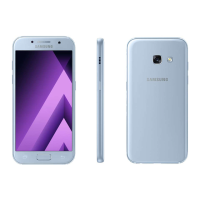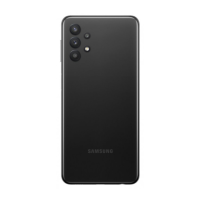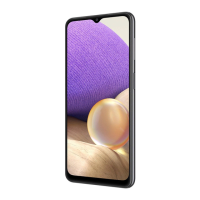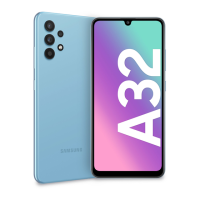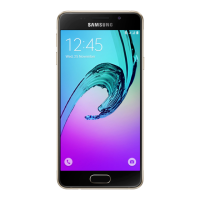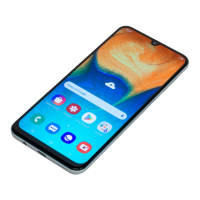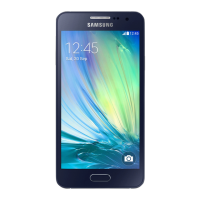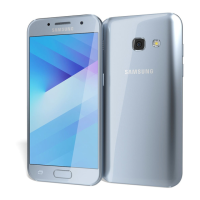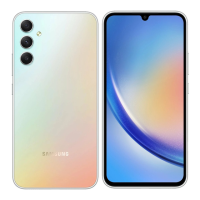Do you have a question about the Samsung SM-A356B/DS and is the answer not in the manual?
Identifies the physical components and their functions on the device.
Details the functions and operations of the device's physical buttons.
Explains the navigation bar soft buttons and their functions on the screen.
Provides instructions on how to charge the device's battery using wired or quick charging.
Guide to inserting and activating Nano-SIM cards and eSIMs for phone connectivity.
Instructions for inserting, using, and managing microSD cards for storage expansion.
Steps for powering the device on, powering it off, and forcing a restart.
Guide to setting up the device for the first time or after a data reset.
Information on making emergency calls and accessing medical information.
How to set up, sign in, find ID/reset password, and sign out of a Samsung account.
Instructions for transferring data using the Smart Switch app via USB cable.
Explanation of how to interact with the device's touch screen using gestures.
Details on the Home screen and Apps screen layout and navigation.
Information on locking the screen, changing lock methods, and indicator icons.
How to open and use the notification panel and quick settings.
Methods for capturing screenshots and recording the device screen.
How to download, install, manage, uninstall, and enable apps on the device.
Managing app permissions to ensure proper operation and protect data.
Guide to making and receiving calls, including international calls and speed dial.
How to add, import, sync, search, delete, and group contacts.
Instructions for sending, checking, sorting, and changing message settings.
Introduction to taking pictures and recording videos, including camera etiquette.
Accessing and managing images and videos stored on the device.
Introduction to AR Zone features and AR Emoji Studio for creating emojis.
Introduction to Bixby, how to start it, and using voice commands.
Using Bixby Vision for image recognition, translation, text extraction, and discovery.
Explanation of split screen and pop-up view for multitasking with apps.
Browsing the internet, bookmarking, and using Secret Mode for privacy.
Features of Samsung Wallet for payments, identity verification, and tickets.
Managing wellness and fitness goals, tracking progress, and checking health tips.
Creating, editing, and deleting notes with text, handwriting, images, or voice recordings.
Support services, device diagnosis, community interaction, news, and tips.
Restricting app access, setting usage times, and managing children's digital use.
Information about the Global Goals for sustainable society.
Accessing free video content and channels.
Mobile shopping service for Samsung products and offers.
Accessing Samsung website and product information.
Managing wearable devices, customising settings, and connecting to the phone.
Managing schedules by creating and syncing events.
Setting to-do items as reminders and managing notifications.
Recording and playing voice memos, with options for standard and speech-to-text modes.
Accessing and managing files stored on the device, including storage management.
Setting alarms, checking time, and timing events.
Performing basic and scientific calculations, with unit conversion.
Gathering games from Play Store/Galaxy Store and managing game performance.
Controlling and managing smart appliances and IoT products.
Sharing images and other content using various methods like Quick Share.
Sharing Bluetooth speaker and listening to music together with Galaxy Buds.
Viewing phone content on a large screen by connecting to a TV or monitor.
Accessing mobile device data and notifications on a Windows computer.
Overview of Google apps like Chrome, Gmail, Maps, YouTube, etc.
Managing Wi-Fi, Bluetooth, and NFC/contactless payment settings.
Managing connections to Quick Share, Music Share, Buds, tablets, computers, and vehicles.
Setting up modes and routines for automated device actions based on conditions.
Customising sound modes, ringtones, notification sounds, and vibration settings.
Changing notification settings for apps, lock screen, and pop-up styles.
Adjusting brightness, motion smoothness, screen modes, font, and screen timeout.
Checking battery status, power saving, background limits, and charging settings.
Customising wallpaper for the Home screen and locked screen.
Applying themes to change the visual elements of the device interface.
Configuring Home screen layout and settings.
Managing lock screen settings, Extend Unlock, and Always On Display.
Managing lock screen, account security, app security, and privacy controls.
Managing location information permissions and services for apps.
Setting up medical info, emergency contacts, SOS, and sharing features.
Syncing, backing up, and restoring data using Samsung Cloud and Google Drive.
Enabling Bixby, smart suggestions, motions, gestures, and dual messenger.
Monitoring device usage and setting parental controls for children.
Optimising device performance, battery, storage, memory, and security.
Managing app settings, notifications, permissions, and uninstalling apps.
Customising language, keyboard, passwords, and resetting device settings.
Improving device accessibility with vision, hearing, and interaction enhancements.
Updating device software via FOTA and scheduling updates.
Getting help for technical problems through the remote support service.
Accessing device status, legal, software, and battery information.
Important precautions for safe and proper device usage, including software and data.
Guidelines to maintain the device's water and dust resistance rating.
Troubleshooting steps for when the device heats up while charging or during use.
Solutions for common device issues like codes, network errors, and power problems.
Identifies the physical components and their functions on the device.
Details the functions and operations of the device's physical buttons.
Explains the navigation bar soft buttons and their functions on the screen.
Provides instructions on how to charge the device's battery using wired or quick charging.
Guide to inserting and activating Nano-SIM cards and eSIMs for phone connectivity.
Instructions for inserting, using, and managing microSD cards for storage expansion.
Steps for powering the device on, powering it off, and forcing a restart.
Guide to setting up the device for the first time or after a data reset.
Information on making emergency calls and accessing medical information.
How to set up, sign in, find ID/reset password, and sign out of a Samsung account.
Instructions for transferring data using the Smart Switch app via USB cable.
Explanation of how to interact with the device's touch screen using gestures.
Details on the Home screen and Apps screen layout and navigation.
Information on locking the screen, changing lock methods, and indicator icons.
How to open and use the notification panel and quick settings.
Methods for capturing screenshots and recording the device screen.
How to download, install, manage, uninstall, and enable apps on the device.
Managing app permissions to ensure proper operation and protect data.
Guide to making and receiving calls, including international calls and speed dial.
How to add, import, sync, search, delete, and group contacts.
Instructions for sending, checking, sorting, and changing message settings.
Introduction to taking pictures and recording videos, including camera etiquette.
Accessing and managing images and videos stored on the device.
Introduction to AR Zone features and AR Emoji Studio for creating emojis.
Introduction to Bixby, how to start it, and using voice commands.
Using Bixby Vision for image recognition, translation, text extraction, and discovery.
Explanation of split screen and pop-up view for multitasking with apps.
Browsing the internet, bookmarking, and using Secret Mode for privacy.
Features of Samsung Wallet for payments, identity verification, and tickets.
Managing wellness and fitness goals, tracking progress, and checking health tips.
Creating, editing, and deleting notes with text, handwriting, images, or voice recordings.
Support services, device diagnosis, community interaction, news, and tips.
Restricting app access, setting usage times, and managing children's digital use.
Information about the Global Goals for sustainable society.
Accessing free video content and channels.
Mobile shopping service for Samsung products and offers.
Accessing Samsung website and product information.
Managing wearable devices, customising settings, and connecting to the phone.
Managing schedules by creating and syncing events.
Setting to-do items as reminders and managing notifications.
Recording and playing voice memos, with options for standard and speech-to-text modes.
Accessing and managing files stored on the device, including storage management.
Setting alarms, checking time, and timing events.
Performing basic and scientific calculations, with unit conversion.
Gathering games from Play Store/Galaxy Store and managing game performance.
Controlling and managing smart appliances and IoT products.
Sharing images and other content using various methods like Quick Share.
Sharing Bluetooth speaker and listening to music together with Galaxy Buds.
Viewing phone content on a large screen by connecting to a TV or monitor.
Accessing mobile device data and notifications on a Windows computer.
Overview of Google apps like Chrome, Gmail, Maps, YouTube, etc.
Managing Wi-Fi, Bluetooth, and NFC/contactless payment settings.
Managing connections to Quick Share, Music Share, Buds, tablets, computers, and vehicles.
Setting up modes and routines for automated device actions based on conditions.
Customising sound modes, ringtones, notification sounds, and vibration settings.
Changing notification settings for apps, lock screen, and pop-up styles.
Adjusting brightness, motion smoothness, screen modes, font, and screen timeout.
Checking battery status, power saving, background limits, and charging settings.
Customising wallpaper for the Home screen and locked screen.
Applying themes to change the visual elements of the device interface.
Configuring Home screen layout and settings.
Managing lock screen settings, Extend Unlock, and Always On Display.
Managing lock screen, account security, app security, and privacy controls.
Managing location information permissions and services for apps.
Setting up medical info, emergency contacts, SOS, and sharing features.
Syncing, backing up, and restoring data using Samsung Cloud and Google Drive.
Enabling Bixby, smart suggestions, motions, gestures, and dual messenger.
Monitoring device usage and setting parental controls for children.
Optimising device performance, battery, storage, memory, and security.
Managing app settings, notifications, permissions, and uninstalling apps.
Customising language, keyboard, passwords, and resetting device settings.
Improving device accessibility with vision, hearing, and interaction enhancements.
Updating device software via FOTA and scheduling updates.
Getting help for technical problems through the remote support service.
Accessing device status, legal, software, and battery information.
Important precautions for safe and proper device usage, including software and data.
Guidelines to maintain the device's water and dust resistance rating.
Troubleshooting steps for when the device heats up while charging or during use.
Solutions for common device issues like codes, network errors, and power problems.
| Model | SM-A356B/DS |
|---|---|
| Type | Li-Po 5000 mAh, non-removable |
| Features | LED flash, panorama, HDR |
| NFC | Yes (market/region dependent) |
| Models | SM-A356B, SM-A356B/DS |
| Technology | GSM / HSPA / LTE |
| 2G bands | GSM 850 / 900 / 1800 / 1900 - SIM 1 & SIM 2 |
| 3G bands | HSDPA 850 / 900 / 1900 / 2100 |
| 4G bands | 1, 3, 5, 7, 8, 20, 28, 38, 40, 41 |
| Build | Glass front, plastic back, plastic frame |
| SIM | Dual SIM (Nano-SIM, dual stand-by) |
| Card slot | microSDXC |
| Internal | 128GB 4GB RAM |
| Ultrawide Camera | 5 MP, f/2.2, 123˚ (ultrawide) |
| Macro Camera | 2 MP, f/2.4, (macro) |
| Video | 1080p@30fps |
| Selfie Video | 1080p@30fps |
| Loudspeaker | Yes |
| WLAN | Wi-Fi 802.11 b/g/n, Wi-Fi Direct |
| Bluetooth | 5.0, A2DP, LE |
| Positioning | GPS, GLONASS, GALILEO, BDS |
| USB | USB Type-C 2.0 |
| Sensors | Accelerometer, compass |



